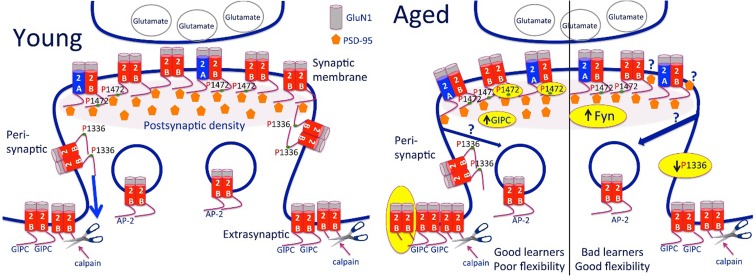Fig. 5.
Summary diagram of changes related to GluN2B-containing NMDA receptors based on age and reference learning status. There was a decrease in GluN2B in the synaptic membrane of the old mice. Previous work suggests that this is due to an increase in triheteromeric (GluN1/2A/2B) NMDA receptors (Zamzow et al. 2013). The old good learners with poor cognitive flexibility showed increased phosphorylation (P) at amino acid 1472 of GluN2B and an increase in GIPC scaffolding protein in the synaptic membrane fraction and an increase in the 115-kDa GluN2B cleavage product in the extrasynaptic membranes compared to young. The old bad learners, with flexibility more similar to the young, showed a decrease in phosphorylation (P) at amino acid 1336 of GluN2B, despite an increase in Fyn kinase. The increased p1472 may be due to a better ability to respond to kinases and/or less recycling in the good learners than the bad. The previous finding of greater PSD-95 per GluN2B in animals with poorer memory (Zamzow et al. 2013) could be due to PSD-95 binding to more sites on the GluN2B tail or diminished trafficking extrasynaptically due to decreased P1336 in the bad learners or increased association between GluN2B and GIPC in the synaptic membrane of the good learners compared to bad. Note: Only GluN2B-containing NMDA receptors are shown. The receptors are shown as tetramers with two GluN1 and two GluN2 subunits. Yellow highlights indicate findings from the present study

